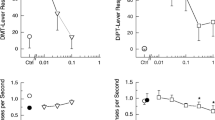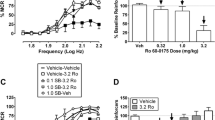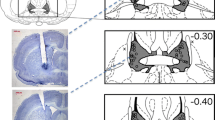Abstract
The functional role of brain 5-HT and 5-HT receptor subtypes in periaqueductal gray (PAG) induced aversion has been investigated in rats. Antiaversive effects were found with the serotonin agonists TFMPP, mCPP and DOI but not with RU 24969 which was found to facilitate PAG aversion. The first three serotonin agonists share potent 5-HT1C activity while RU 24969 differs with a high 5-HT1A activity. Proaversive effects were found with the mixed 5-HT1C/5-HT2 antagonists cyproheptadine and ritanserin; this effect was already reported for the mixed 5-HT1C/5-HT2 antagonists metergoline and mianserin and is opposite to the effects of the selective 5-HT2 antagonists ketanserin, pirenperone, trazodone and spiperone. The antiaversive effects of mCPP (1 mg/kg) could be prevented by pretreatment of the animals with mianserin (1 and 10 mg/kg). These results suggest that 5-HT1C receptors play an important role in the serotonergic control of PAG aversion. 5-HT1C receptor activation seems to mediate antiaversive effects whereas acute 5-HT1C receptor blockade appears to facilitate PAG aversion. Functional interactions take place between several receptor types in the in vivo control of PAG aversion, where 5-HT1C receptors appear to play a predominant function.
Similar content being viewed by others
References
Aulakh CS, Cohen RM, Hill JL, Murphy DL, Zohar J (1987) Long-term imipramine treatment enhances locomotor and food intake suppressant effects of m-chlorophenylpiperazine in rats. Br J Pharmacol 91:747–752
Berendsen HHG, Smets RJM, Broekkamp CLE (1989) Functional interplay of serotonin (5-HT) receptor subtypes. In: Archer T, Bevan B, Cools AR (eds) Behavioural pharmacology of 5-HT. Lawrence Erlbaum Sussex (in press)
Bovier P, Broekkamp CLE, Lloyd KG (1982) Enhancing GA-BAergic transmission reverses the aversive state in rats induced by electrical stimulation of the periaqueductal gray region. Brain Res 248:313–320
Bovier P, Broekkamp CLE, Lloyd KG (1984) Ethyl alcohol on escape from electrical periaqueductal gray stimulation in rats. Pharmacol Biochem Behav 21:351–356
Dabire H, Cherqui C, Fournier B, Schmitt H (1987) Comparison of effects of some 5-HT1 agonists on blood pressure and heart rate of normotensive anaesthetized rats. Eur J Pharmacol 140:259–266
Deakin JFW, Pennell I (1986) 5-HT receptor subtypes and depression. Psychopharmacology 89:S12
Delgado JM, Robert W, Miller NE (1954) Learning motivated by electrical stimulation of the brain stem. Am J Physiol 179:587–593
Dourish CT, Clark ML, Fletcher A, Iversen SD (1989) Evidence that blockade of postsynaptic 5-HT1 receptors elicits feeding in satiated rats. Psychopharmacology 97:54–58
Graeff FG (1984) The anti-aversive action of minor tranquilizers. TIPS 5:230–233
Graeff FG, Brandao ML, Audi EA, Schütz MTB (1986) Modulation of the brain aversive system by gabaergic and serotonergic mechanisms. Behav Brain Res 22:173–180
Graeff FG (1988) Animal models aversion. In: Simon P, Soubrié P, Widlocher D (eds) Animal models of psychiatric disorders, vol 1: selected models of anxiety, depression and psychosis. Karger, Basel
Gudelsky GA, Koenig JI, Meltzer HI (1986) Thermoregulatory responses to serotonin (5-HT) receptor stimulation in the rat. Evidence for opposing roles of 5-HT2 and 5-HT1A receptors. Neuropharmacology 25:1307–1313
Heuring RE, Peroutka SJ (1987) characterization of a novel3H-5-hydroxytryptamine binding site subtype in bovine brain membranes. J Neurosci 7:894–903
Hoyer D (1988a) Molecular pharmacology and biology of 5-HT1C receptors. TIPS 9:89–94
Hoyer D (1988b) Functional correlates of serotonin 5-HT1 recognition sites. J Recept Res 8:59–81
Jenck F, Broekkamp CLE, Van Delft AML (1989a) Effects of serotonin antagonists on PAG stimulation induced aversion: different contribution of 5-HT1, 5-HT2 and 5-HT3 receptors. Psychopharmacology 97:489–495
Jenck F, Broekkamp CLE, Van Delf AML (1989b) Opposite control mediated by 5-HT1A and non 5-HT1A (5-HT1B or 5-HT1C) receptors on periaqueductal gray aversion. Eur J Pharmacol 161:219–221
Julius D, McDermott AB, Axel R, Jessell TM (1988) Molecular characterization of a functional cDNA encoding the serotonin 1C receptor. Science 241:558–564
Kennett GA, Curzon G (1988a) Evidence that hypophagia induced by mCPP and TFMPP requires 5-HT1C and 5-HT1B receptors; hypophagia induced by RU 24969 only requires 5-HT1B receptors. Psychopharmacology 96:93–100
Kennett GA, Curzon G (1988b) Evidence that mCPP may have behavioural effects mediated by 5-HT1C receptors. Br J Pharmacol 94:137–147
Kiser RS, German DC, Lebovitz RM (1978) Serotonergic reduction of dorsal central gray area stimulation-produced aversion. Pharmacol Biochem Behav 9:27–31
Leysen JE, Awouters F, Vennis L, Laduron PM, Vandenberk J, Janssen PAJ (1981) Receptor binding profile of R 41468, a novel antagonist at 5-HT2 receptors. Life Sci 28:1015–1022
Marek GJ, Seiden LS (1988) Effects of selective 5-Hydroxytryptamine-2 and non-selective 5-hydroxytryptamine antagonists on the differential-reinforcement-of-low-rate 72-seconds schedule. J Pharmacol Exp Ther 244:650–656
Mendelson SD, Gorzalka BB (1985) A facilitatory role for serotonin in the sexual behavior of the female rat. Pharmacol Biochem Behav 2:1025–1033
Nashold BS, Wilson WP, Slaughter DG (1969) Sensations evoked by stimulation of the midbrain of man. J Neurosurg 30:14–24
Olds ME, Olds J (1963) Approach-avoidance analysis of rat diencephalon. J Comp Neurol 120:259–295
Paxinos G, Watson C (1982) The rat brain in stereotaxic coordinates. Academic Press, New York
Pazos A, Hoyer D, Palacios JM (1984) The binding of serotonergic ligands to the porcine choroid plexus: characterization of a new type of serotonin recognition site. Eur J Pharmacol 106:539–546
Sanders-Bush E, Breeding M (1988) Putative selective 5-HT2 antagonists block serotonin 5-HT1C receptors in the choroid plexus. J Pharmacol Exp Ther 247:169–173
Schenberg LC, Graeff FG (1978) Role of the periaqueductal gray substance in the antianxiety action of benzodiazepines. Pharmacol Biochem Behav 9:287–295
Schütz MTB, De Aguiar JC, Graeff FG (1985) Antiaversive role of serotonin in the dorsal periaqueductal gray matter. Psychopharmacology 85:340–345
Titeler M, Lyon RA, Glennon RA (1988) Radioligand binding evidence implicates the brain 5-HT2 receptor as a site of action for LSD and phenylisopropylamine hallucinogens. Psychopharmacology 94:213–216
Wozniak KM, Aulakh CS, Hill JL, Murphy DL (1989) Hyperthermia induced by mCPP in the rat and its modification y antidepressant treatments. Psychopharmacology 97:269–274
Author information
Authors and Affiliations
Rights and permissions
About this article
Cite this article
Jenck, F., Broekkamp, C.L.E. & Van Delft, A.M.L. 5-HT1C receptors in the serotonergic control of periaqueductal gray induced aversion in rats. Psychopharmacology 100, 372–376 (1990). https://doi.org/10.1007/BF02244609
Received:
Revised:
Issue Date:
DOI: https://doi.org/10.1007/BF02244609




